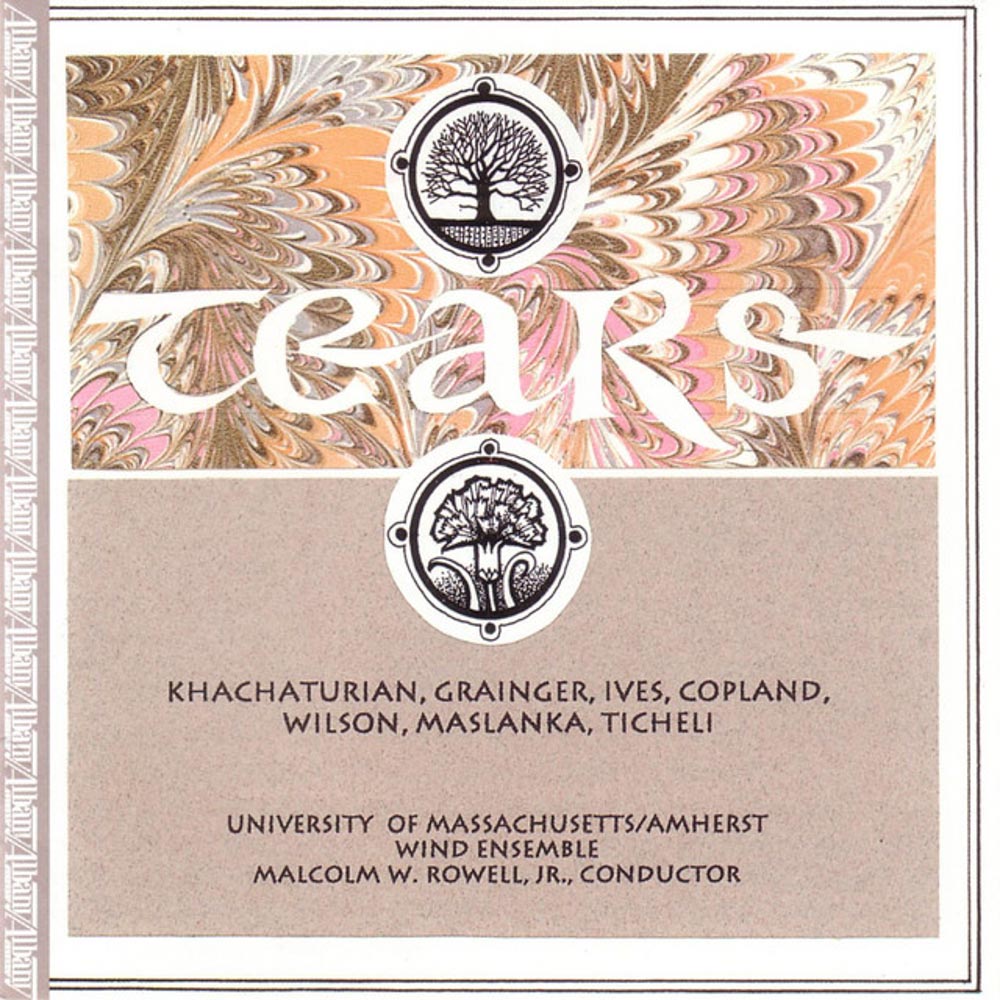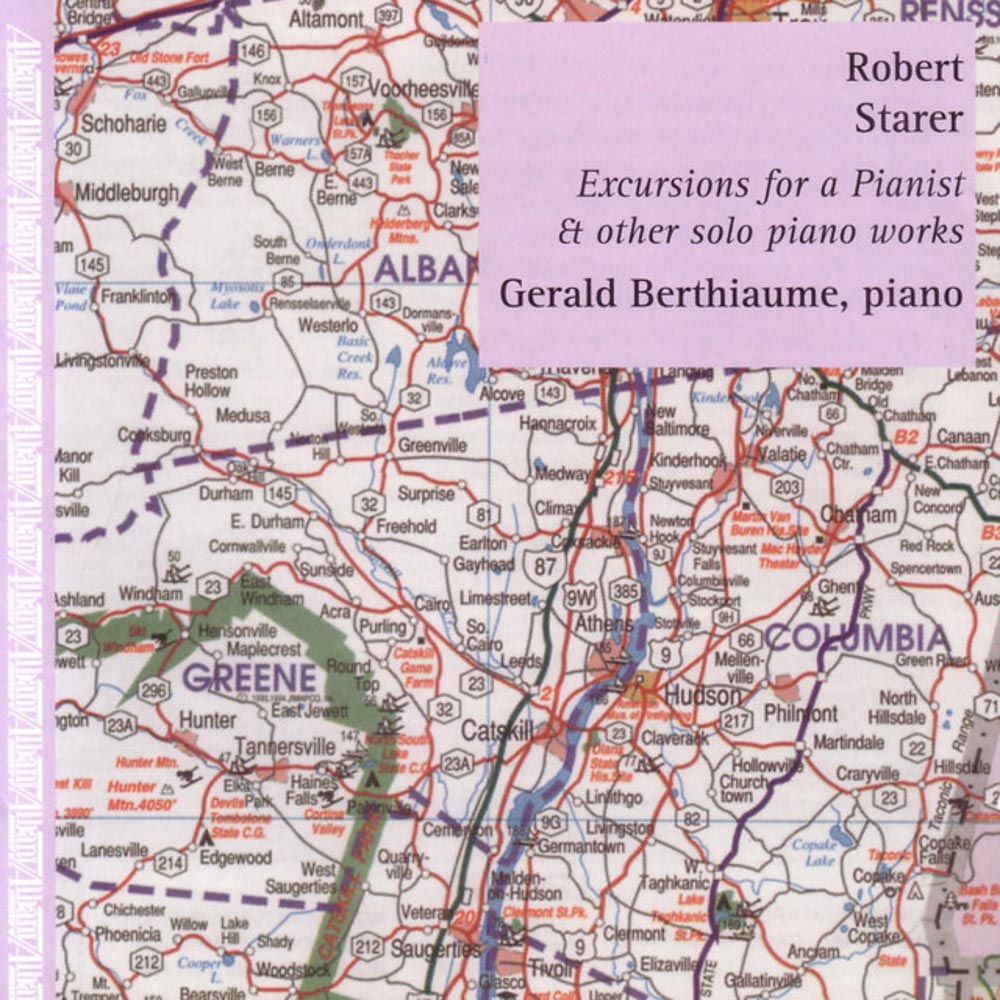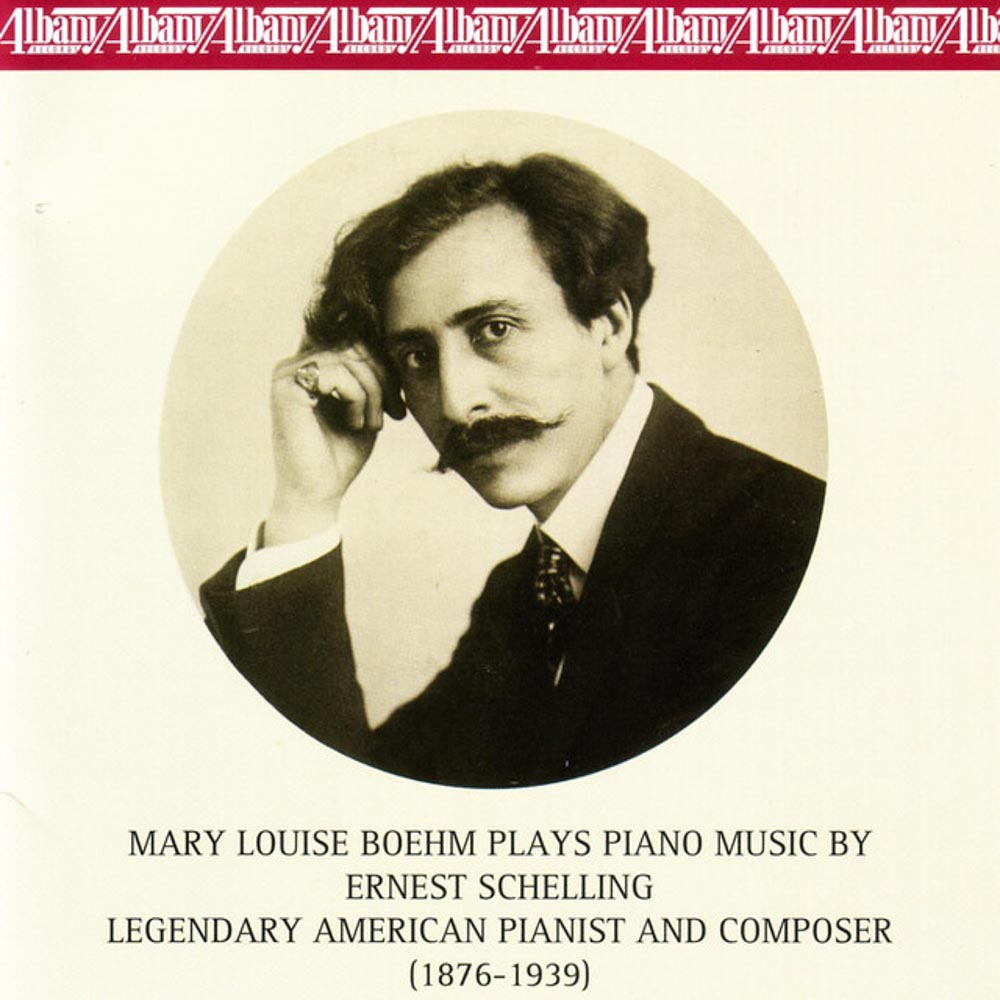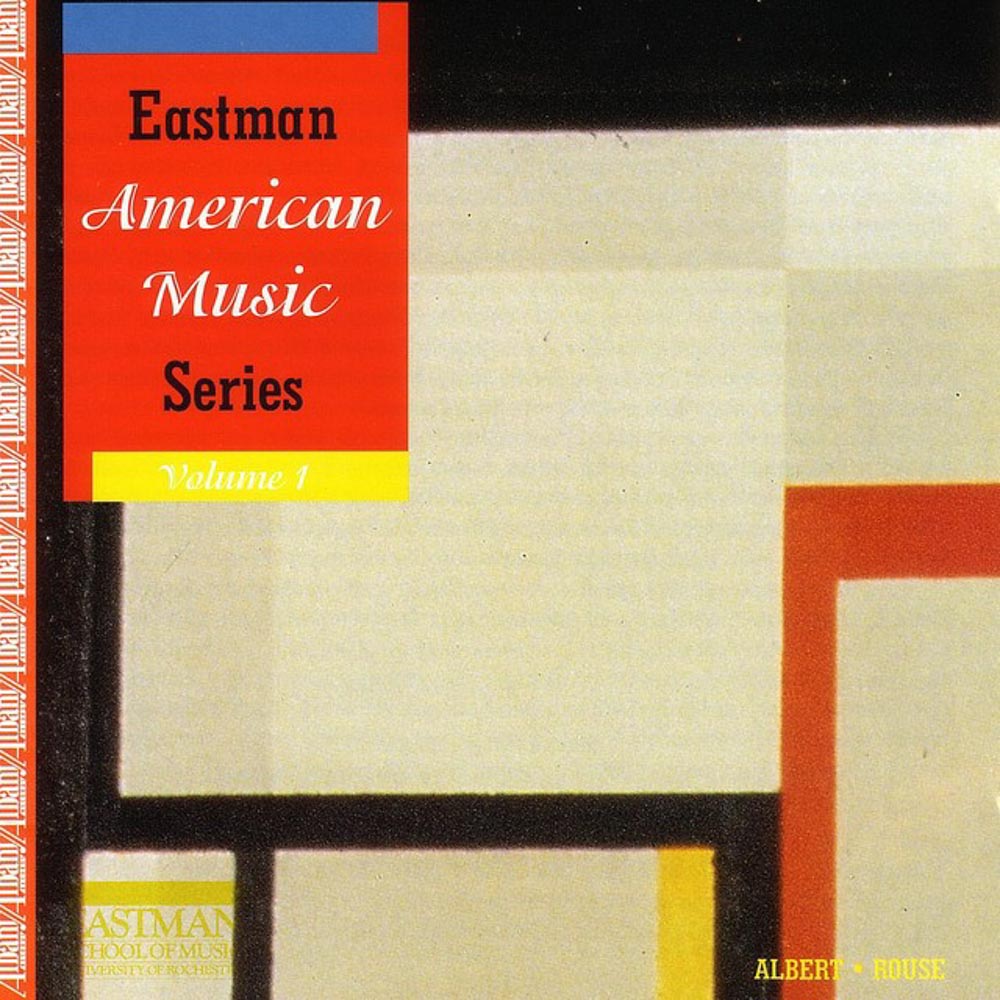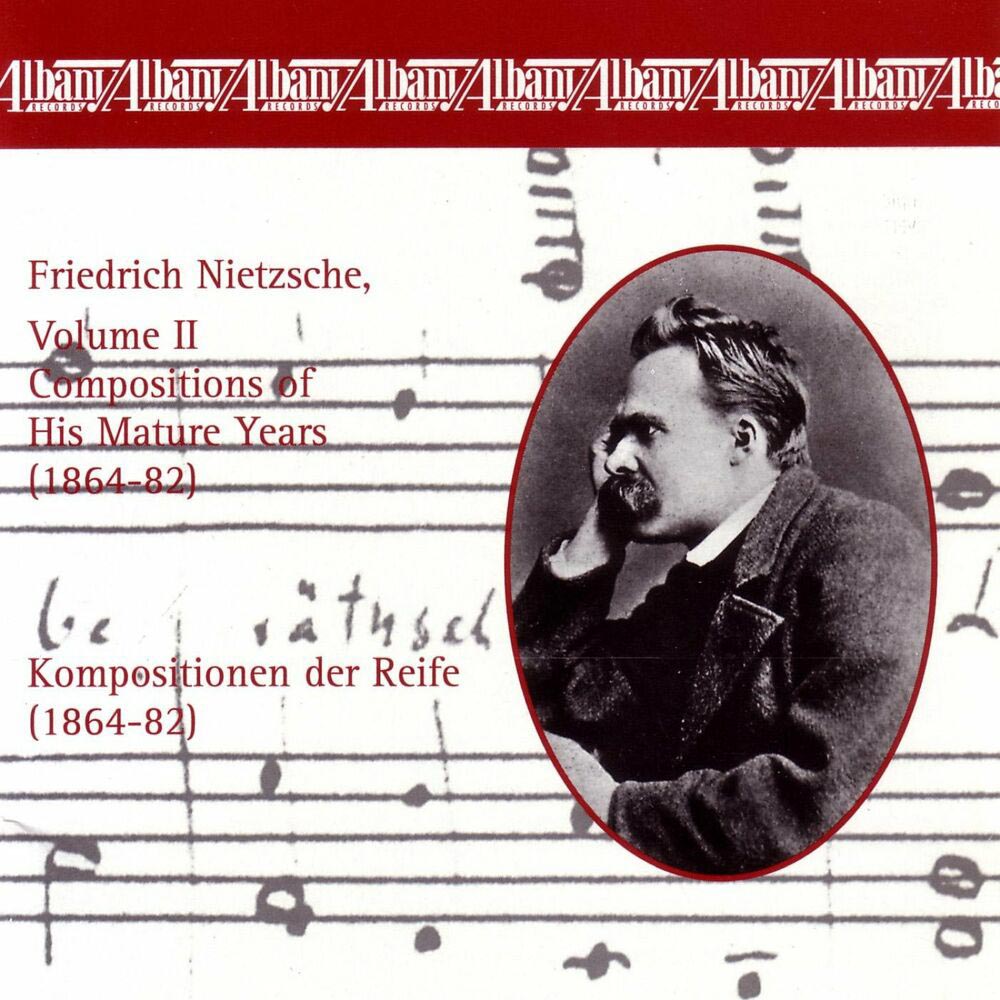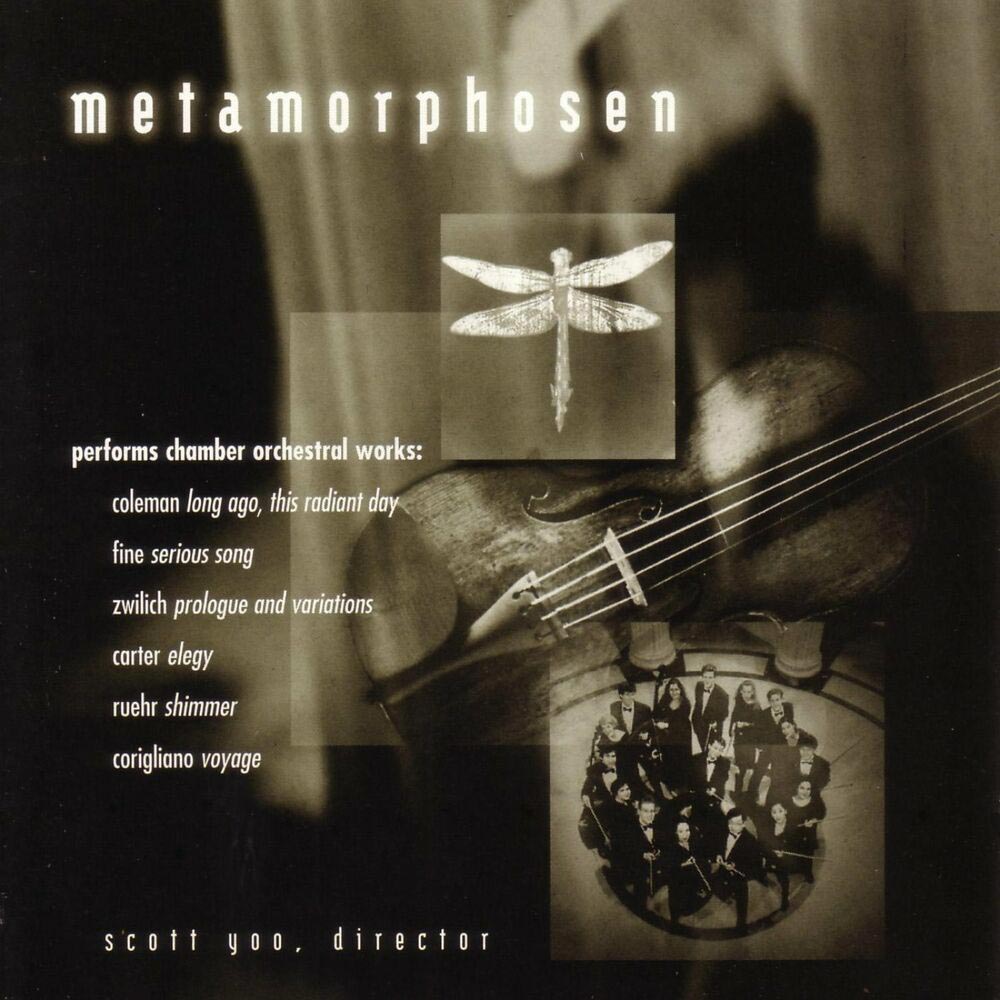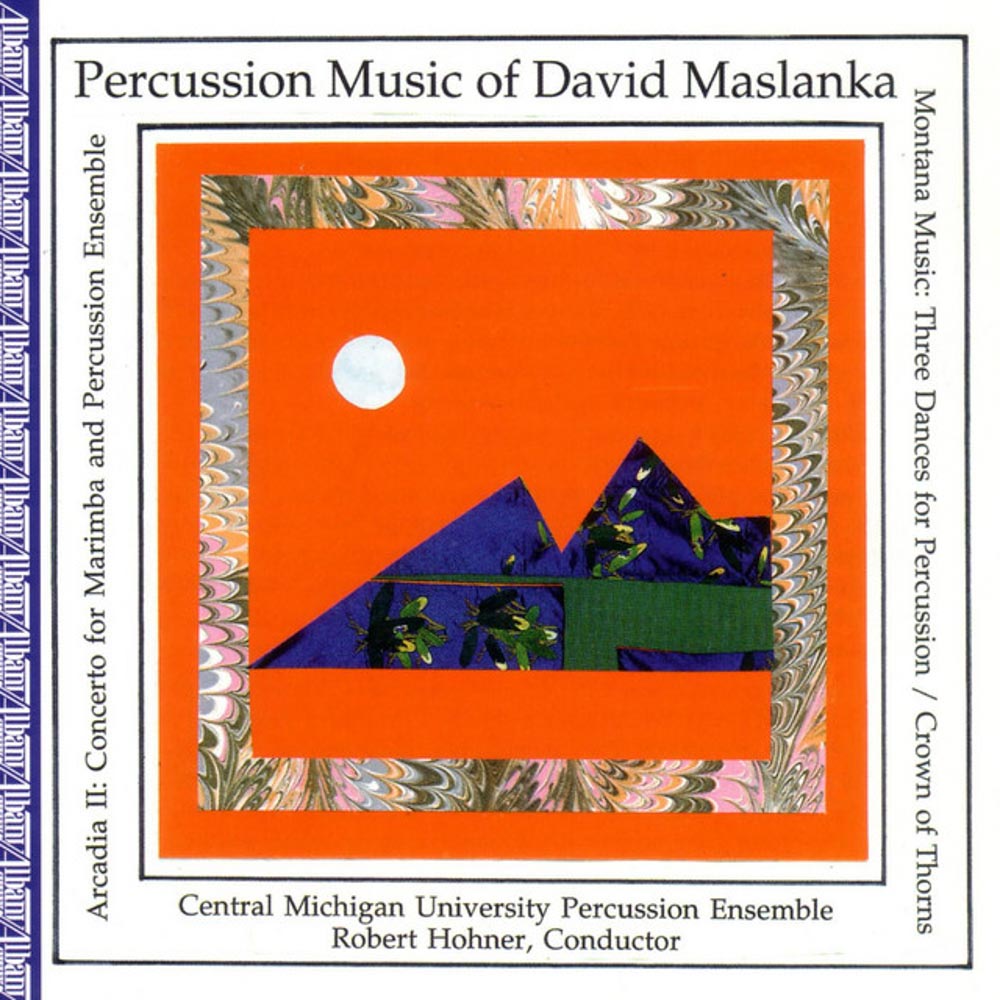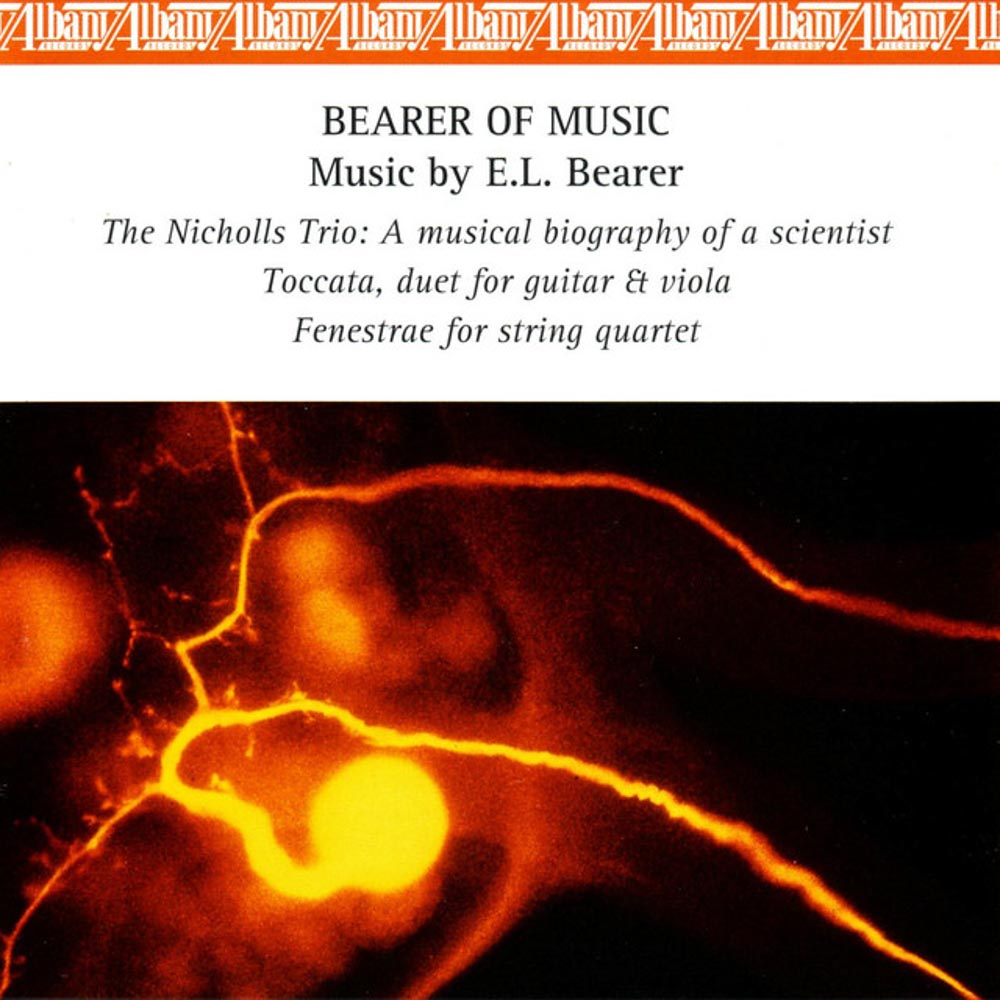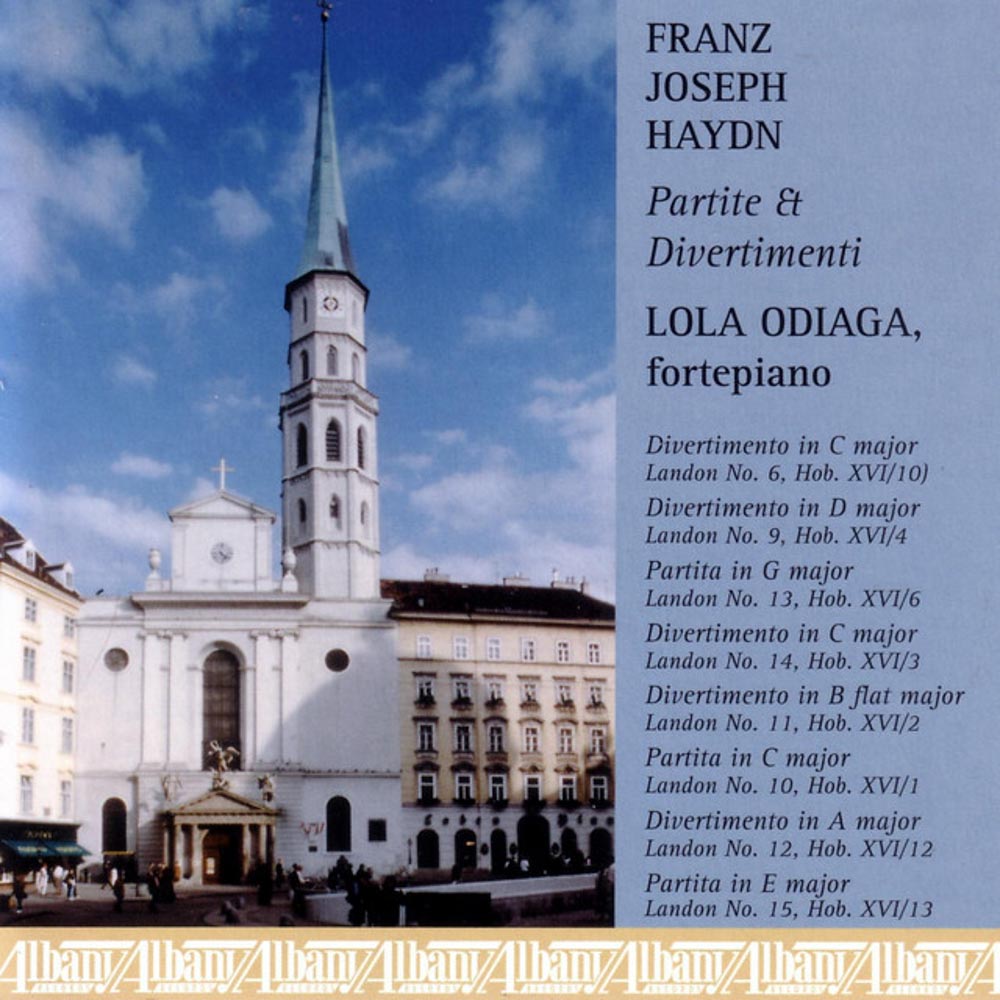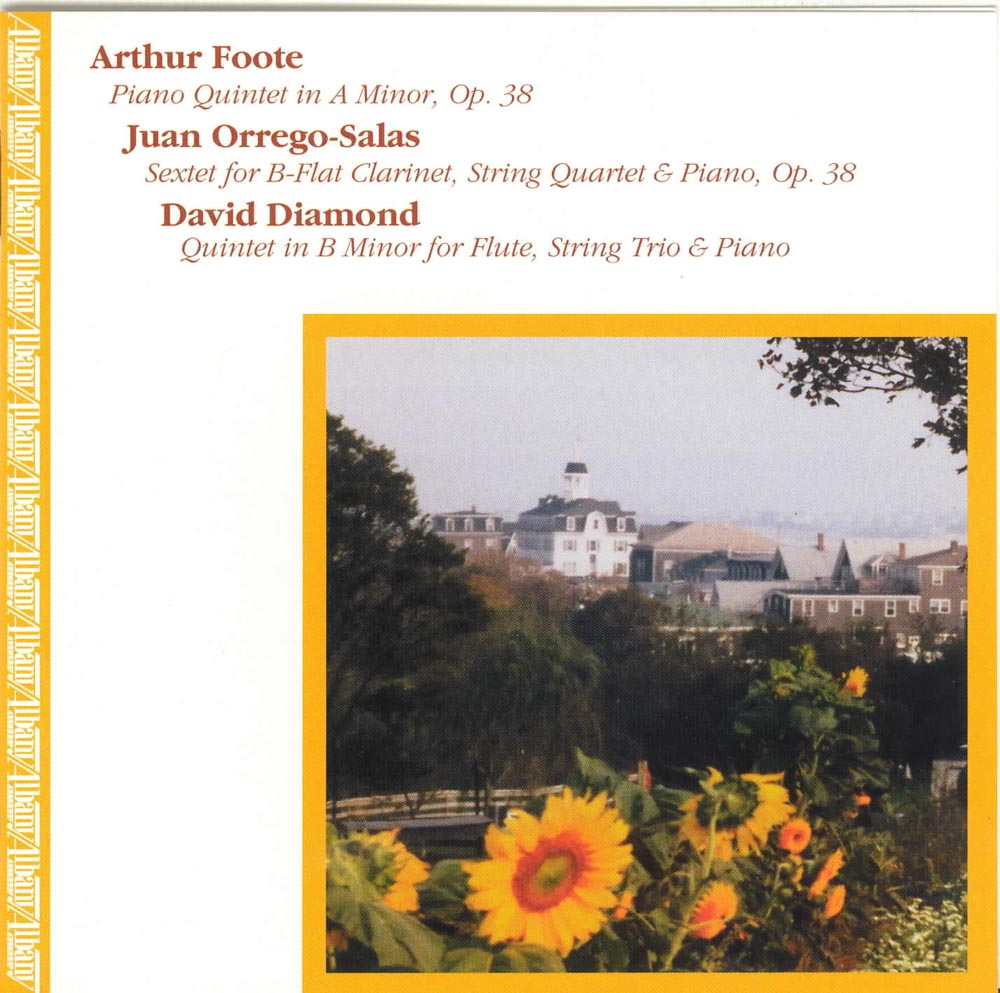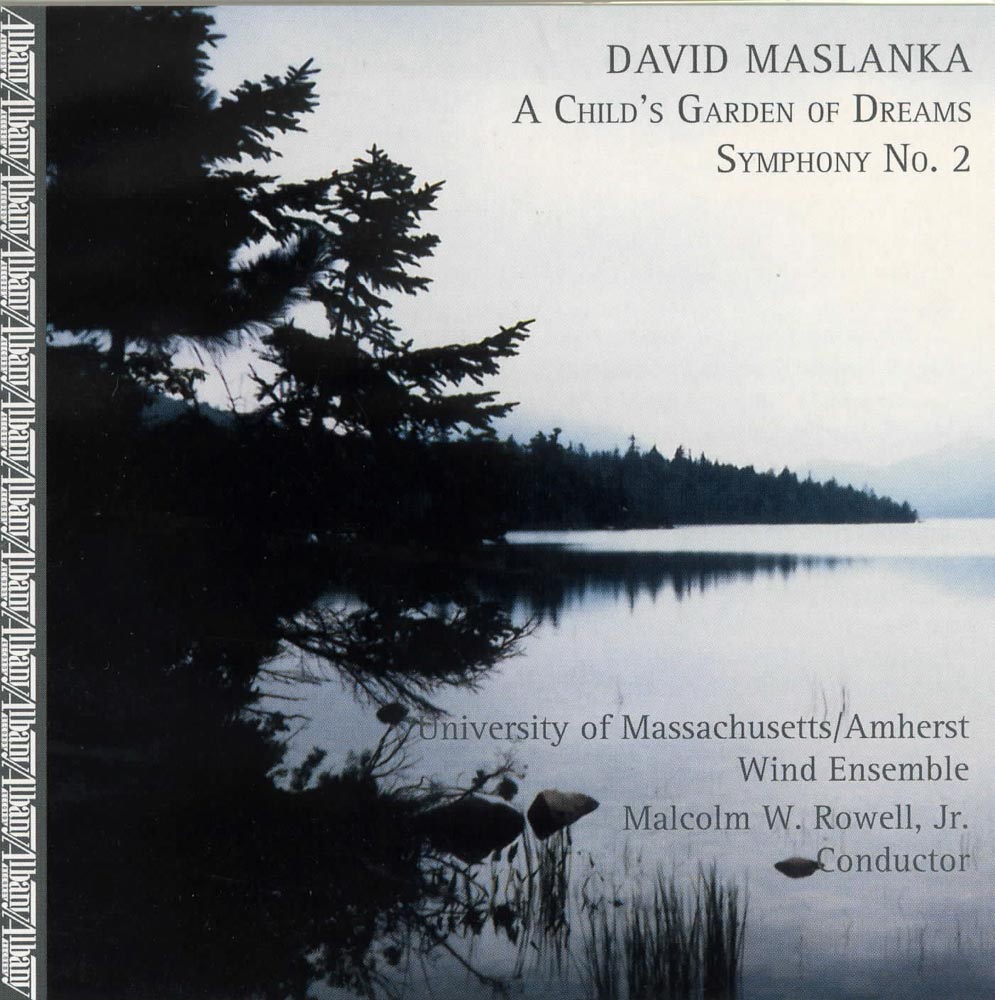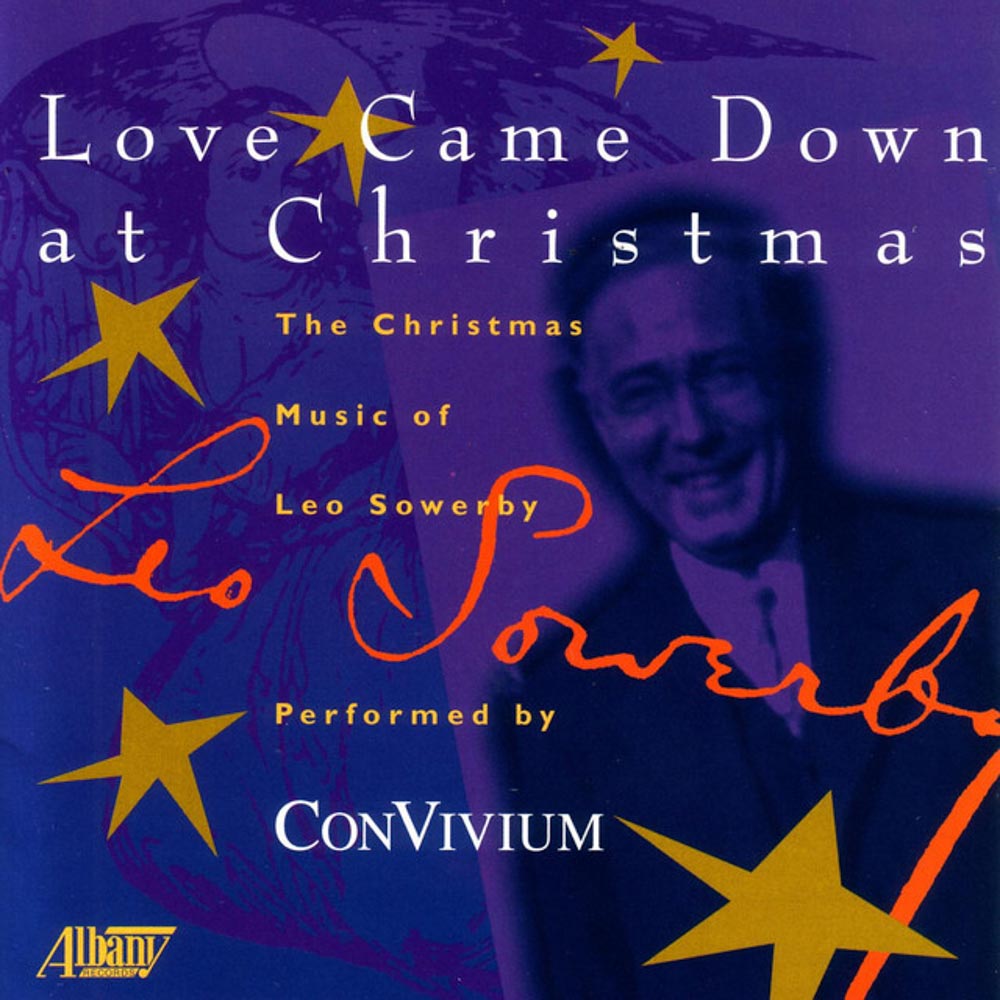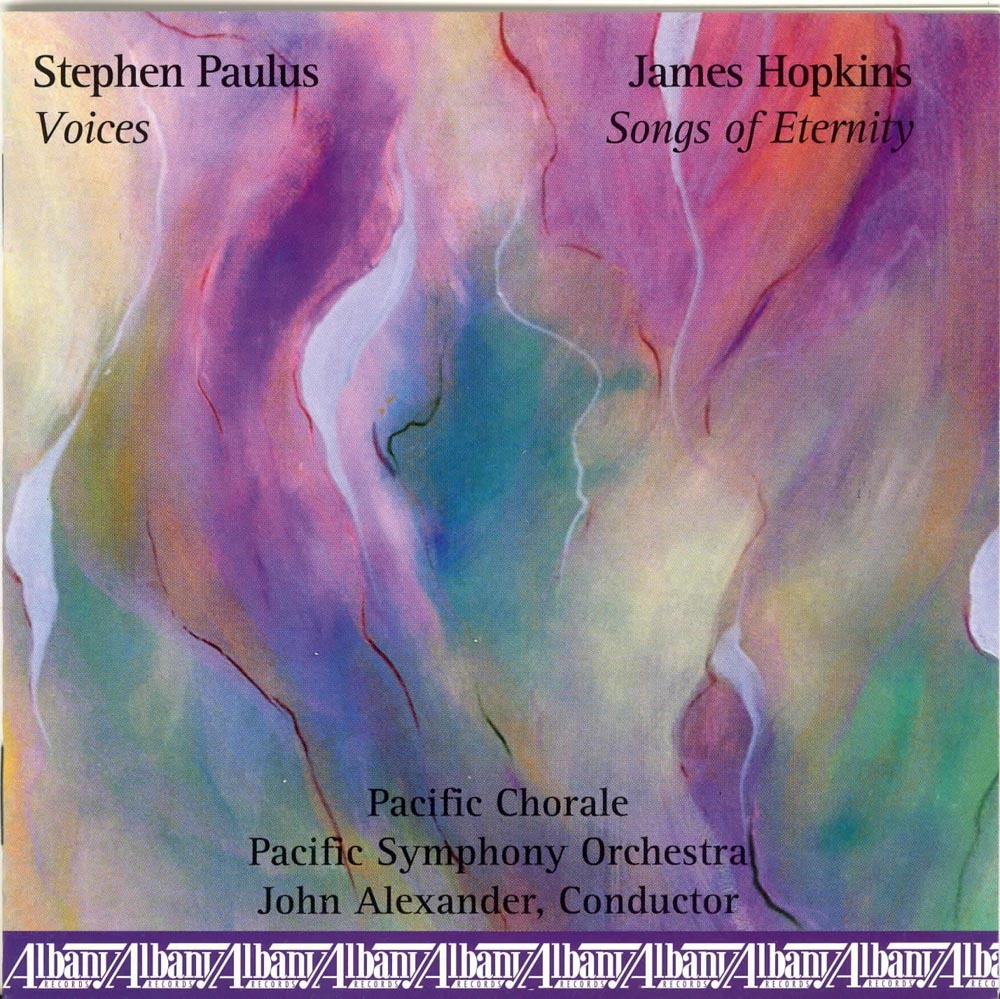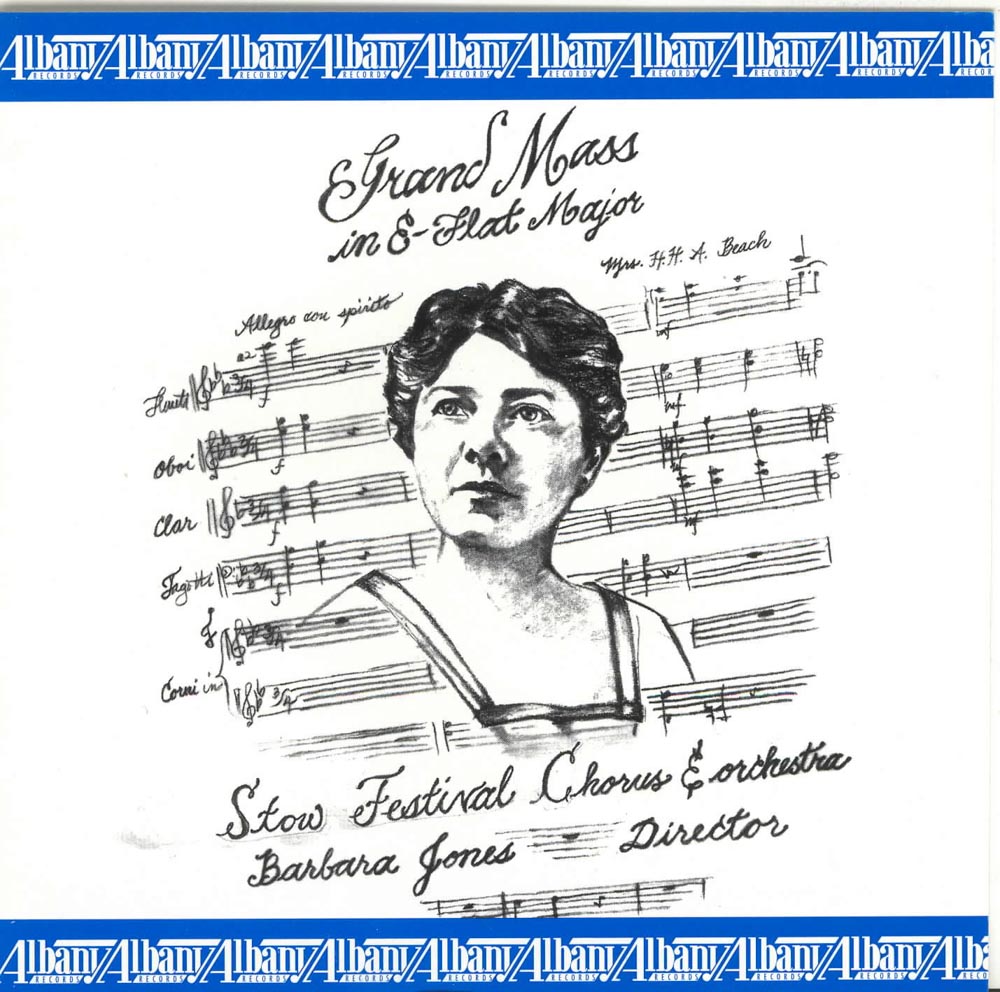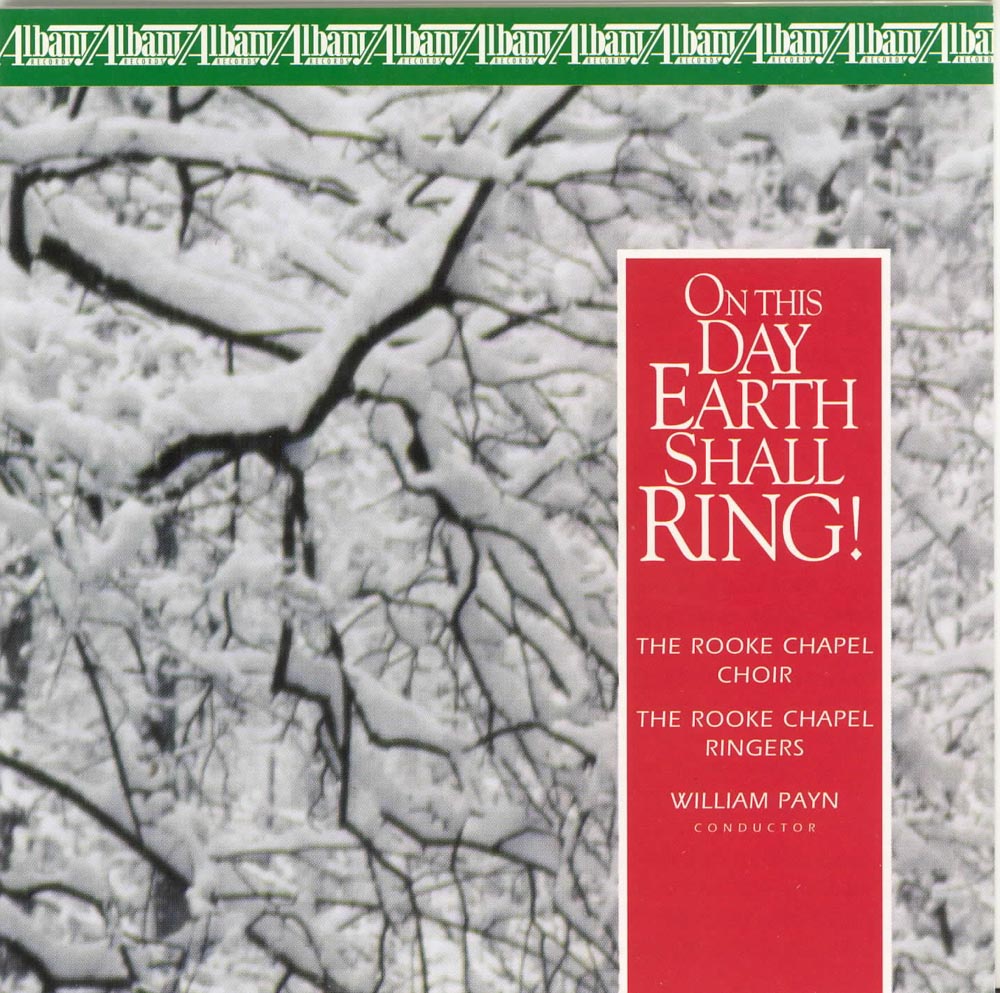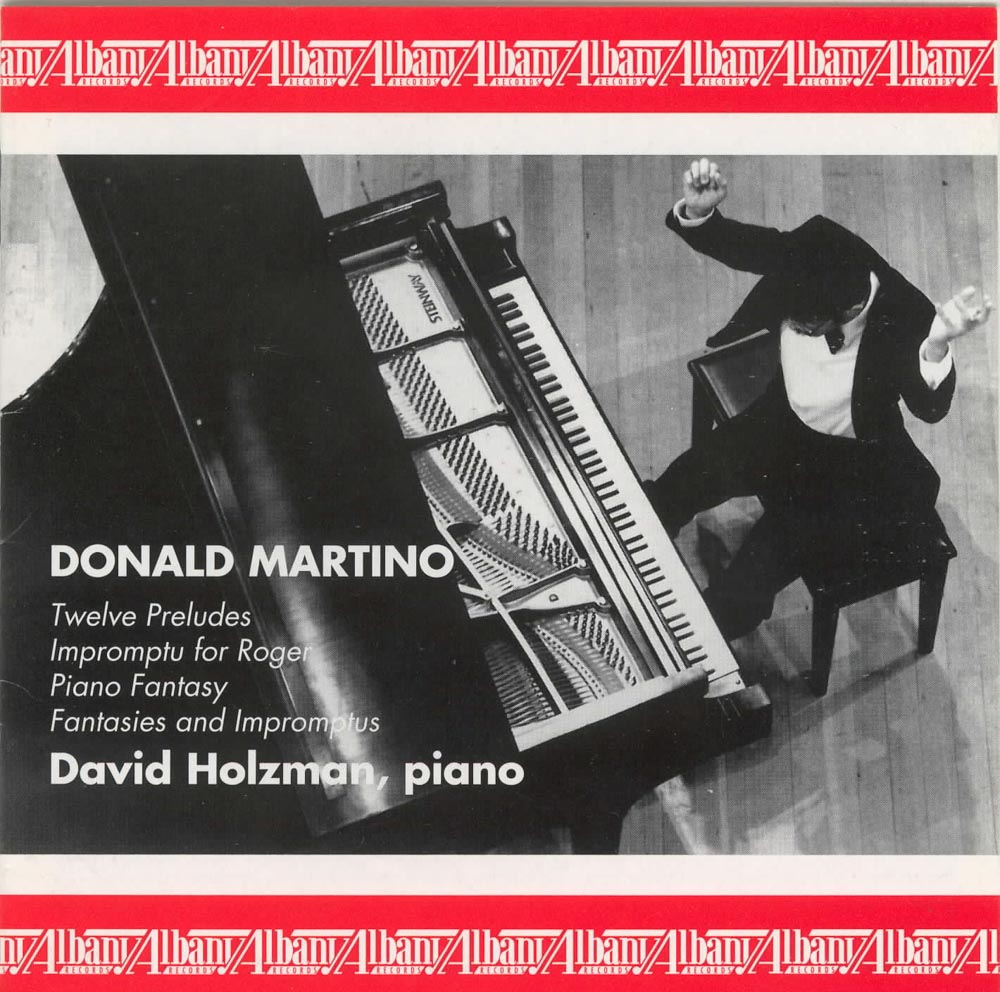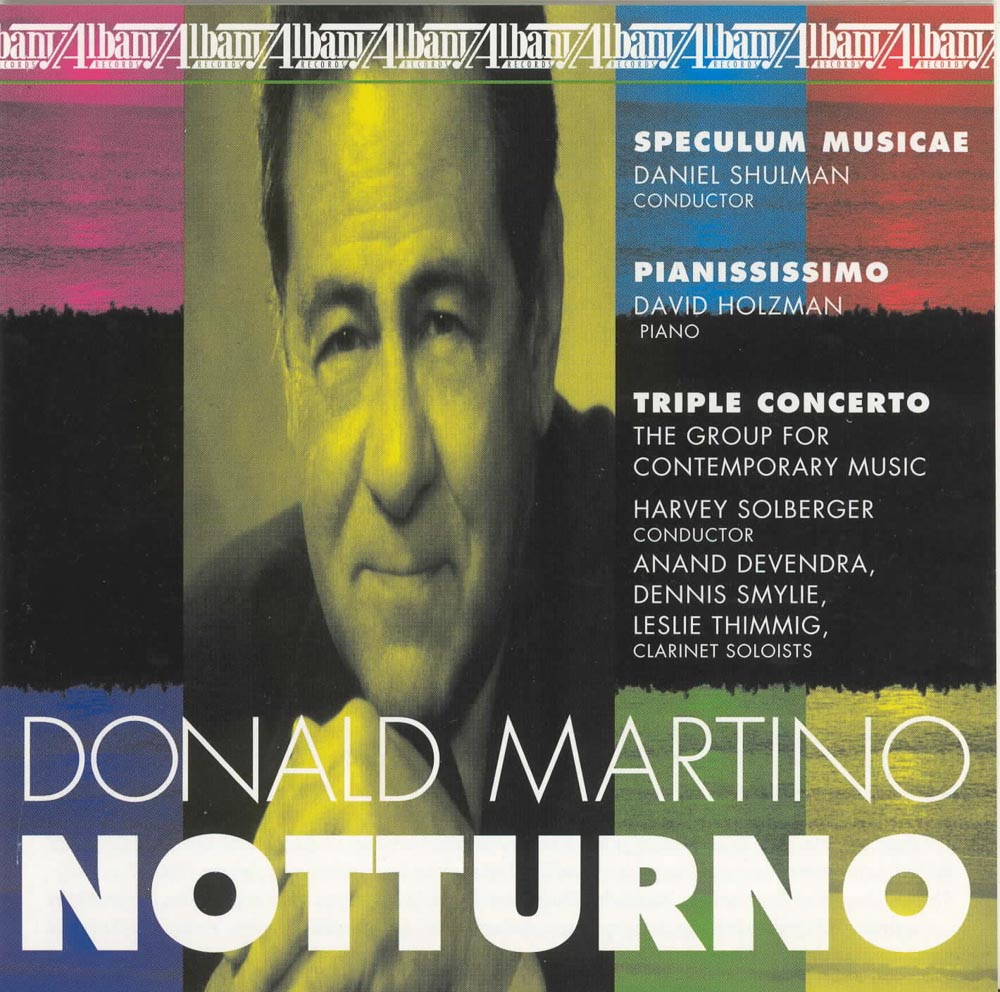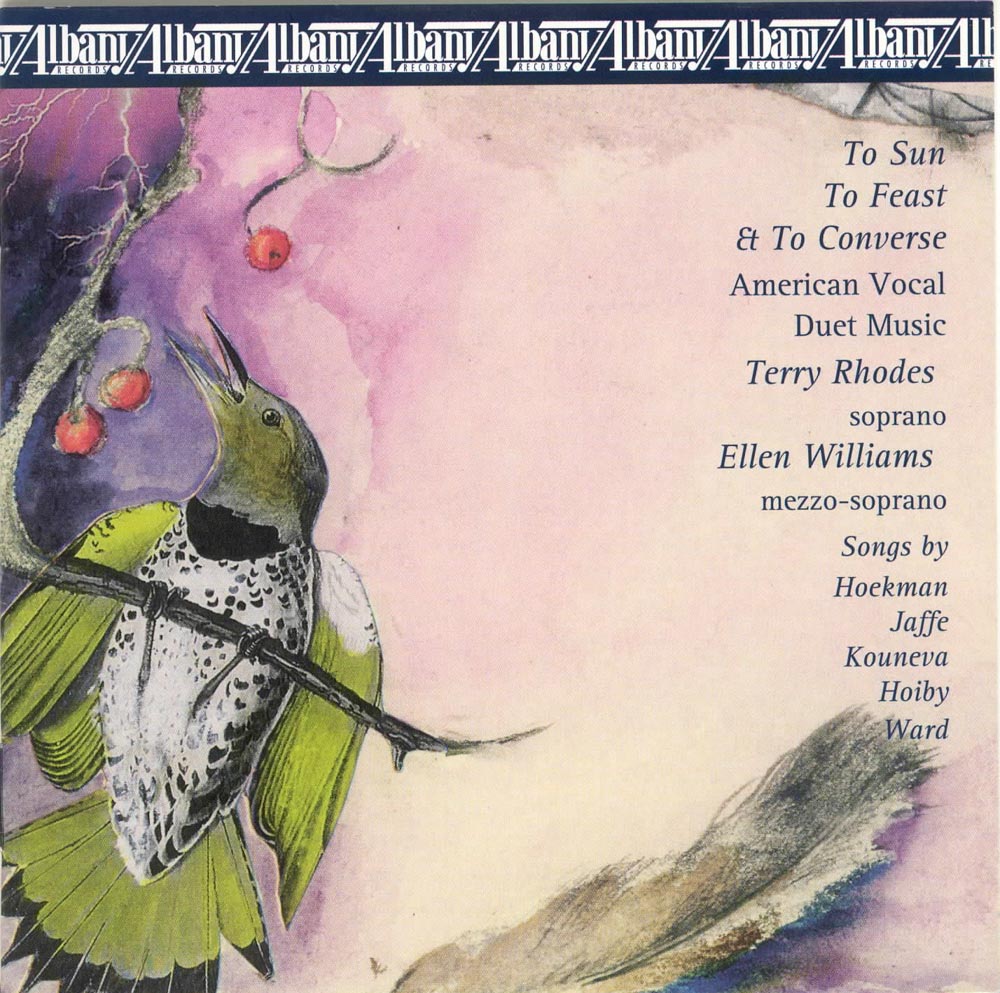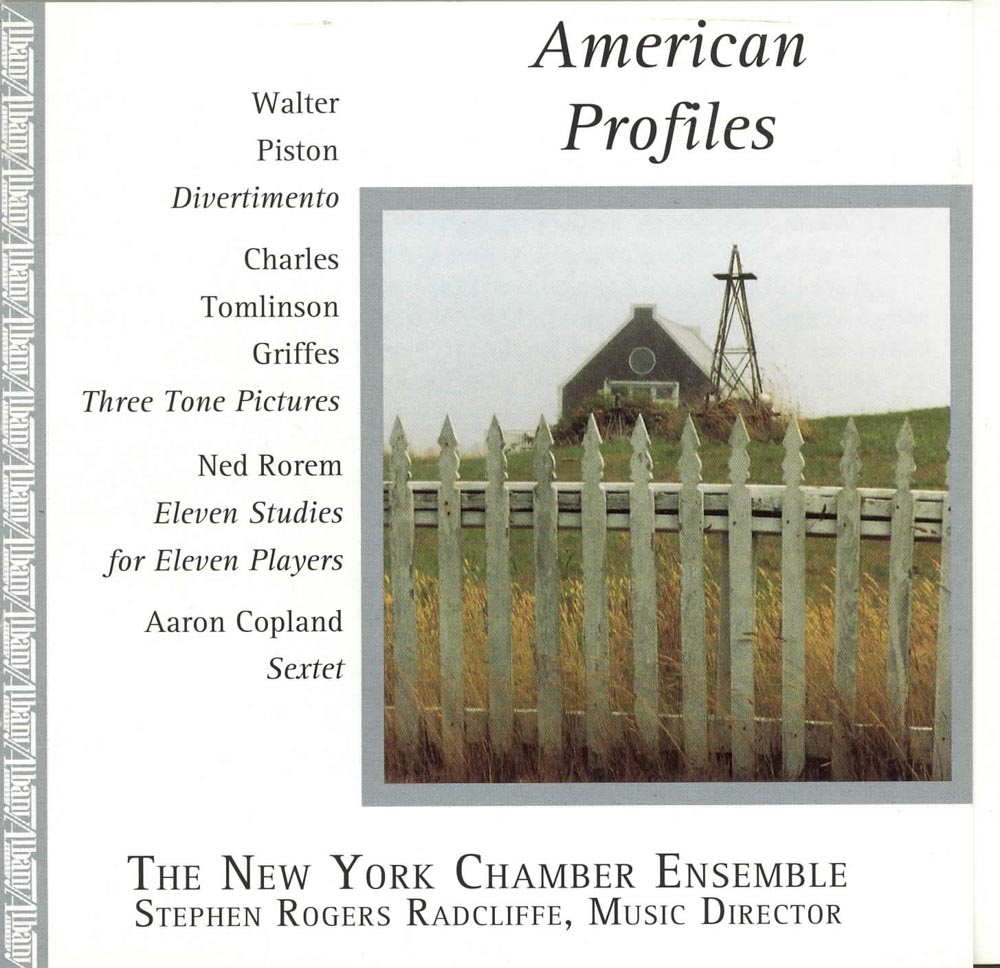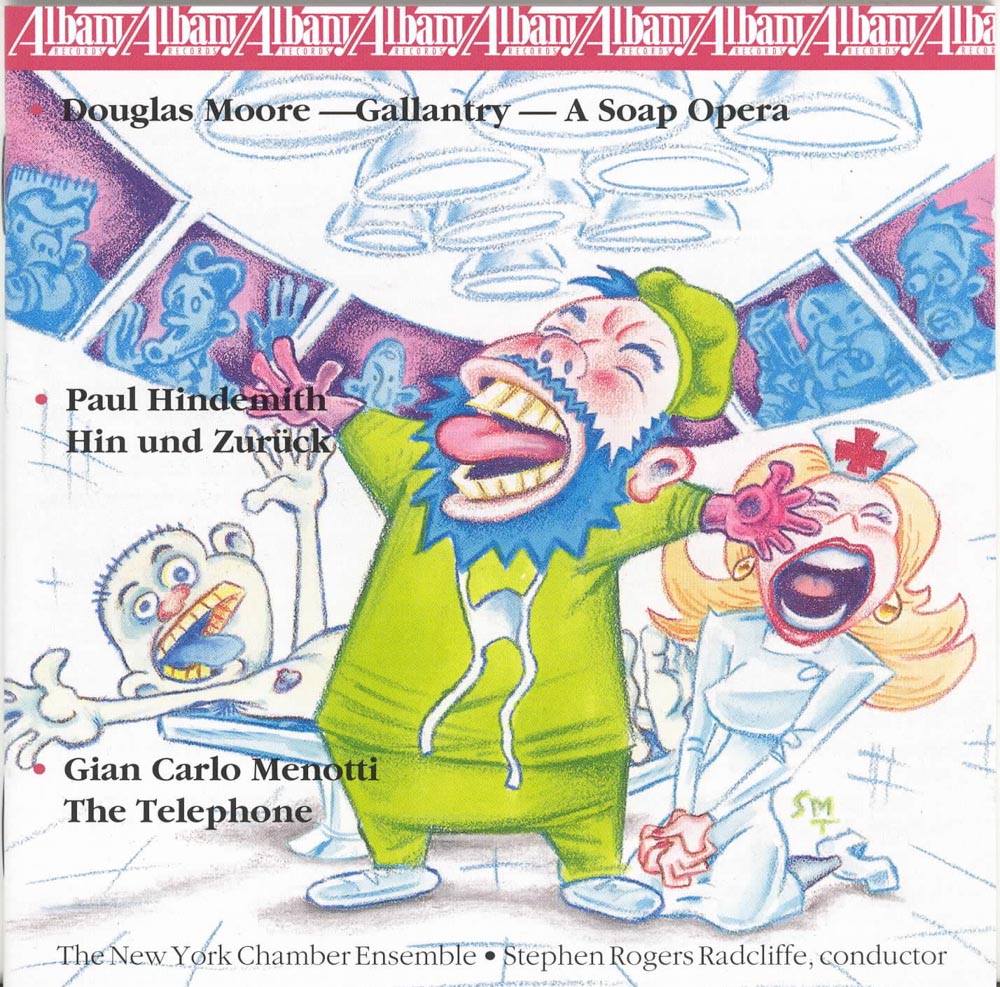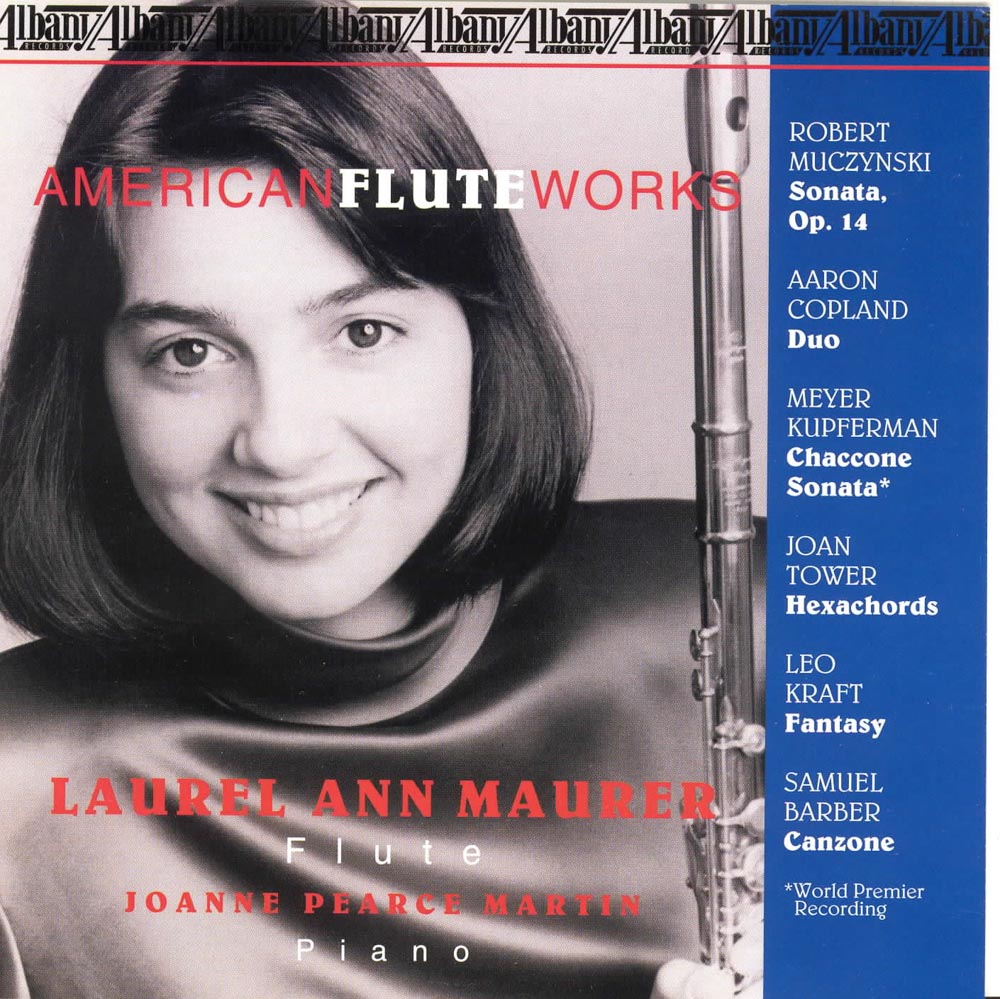Catalog #: TROY0206
Release Date: September 1, 1996Wind EnsembleLet's take a look at the unfamiliar music contained on this disc. About Tears David Maslanka writes: "Tears is about inner transformation, and about groping towards the voice of praise. As St. Francis and St. Ignatius have it, the proper function of the human race is to sing praise. Tears is about inner breaking, and coming to terms with the pain that hinders the voice of praise; Tears is about the movement toward the heart of love." This is a recent piece from Mr. Maslanka's pen. Dana Wilson completed his Dance of the New World the same month - 500 years later - than Columbus first landed in the New World. He wanted in this piece to pay tribute to the blending of styles and attitudes that has taken place in the Latin American region of this hemisphere where Columbus first landed. Frank Ticheli's Postcard was first performed by the University of Michigan Symphony Band on April 17, 1992. Mr. Ticheli is a graduate of the University of Michigan and now teaches at the University of Southern California where he is Assistant Professor of Music. He is also composer-in-residence with the Pacific Symphony Orchestra.
Catalog #: TROY0203
Release Date: September 1, 1996InstrumentalThis is an interesting recital. It is good to see the piano music of Shchedrin and the Bulgarian composer Vladigerov beginning to appear on CD. Krassimira Jordan was born in Varna, Bulgaria of Russian and Bulgarian parents. She studied in Sofia, Vienna and Moscow and was a pupil of Stanislav Neuhaus and Emil Gilels. She became a naturalized citizen of Austria and became Professor of Piano at the Vienna Academy of Music and Dramatic Arts from 1979-1989. After her American debut at Carnegie Hall in 1989, she joined the faculty of the Baylor University School of Music as Artist-in-Residence and Professor of Piano. Highly regarded as a teacher, her students come from all parts of the world and have won top prizes at numerous international piano competitions. She is a fine performer and this music suits her temperament perfectly. As a result, this is a most satisfying disc.
Catalog #: TROY0199
Release Date: September 1, 1996ChamberJohn Davison (b. 1930) grew up in upper New York State and New York City. He studied music at the Juilliard lower school, Haverford College, Harvard and Eastman. Among his teachers were Randall Thompson, Walter Piston, Bernard Rogers, Howard Hanson and Alan Hovhaness. He has taught at Haverford College since 1959. His musical idiom is rooted in the great Western classic-romantic tradition with Baroque, Renaissance, jazz, modernist and folk elements mixing in at times. His Sonata for Horn and Piano was composed for the bicentennial of Franklin and Marshall College in 1987. It is a big, romantic work. The Sonata No. 1 for Violin and Piano was composed for the violinist who performs it on this disc, Carol Stein Amado, who gave the work its premiere in the Carnegie Recital Hall in 1976. All the works on this disc are receiving their world premiere recordings. Mr. Davison's music is most pleasing and can be easily enjoyed by anyone who has an interest in twentieth century American music.
Catalog #: TROY0191
Release Date: September 1, 1996ChamberAll the performances on this disc are world premieres. Mario Castelnuovo-Tedesco was born and educated in Florence. He studied composition with Ildebrando Pizzetti and was noticed by Alfredo Casella when he was still a young man. He worked as a pianist and freelance composer until 1939. Then, sensing the approaching danger of the Second World War, he fled fascist Italy and settled in Beverly Hills, California, where he lived and worked until his death in 1968. His early music, with its distinctive use of Italian lyricism combined with the techniques of French impressionism, made him a welcome member of the Italian progressive school. He found his greatest sources of inspiration in the Bible, his Jewish heritage and in his native Tuscany. He was a great melodist and continued to compose right up until the end of his life. Towards the end he also composed music for films. His music was performed by Toscanini, Heifetz, Segovia and Piatagorsky.
Catalog #: TROY0205
Release Date: August 1, 1996InstrumentalRobert Starer was born in Vienna and received his musical education at the State Academy in Vienna, the Jerusalem Conservatory and Juilliard. He has lived in New York since 1947 and became a United States citizen in 1957. Among his honors are two Guggenheim Fellowships. He was elected a member of the American Academy of Arts and Letters in 1994. In 1996 he was awarded the achievement award by the Music Teachers National Association "in recognition of his distinguished career in music and outstanding contributions to his profession as composer and educator." The pianist, Gerald Berthiaume, is currently as Associate Professor of Music at Washington State University where he serves as coordinator of keyboard studies. Prior to his appointment there in 1989, he served in a similar position at Lamar University in Beaumont, Texas. He is a graduate of the New England Conservatory of Music. This recital of Robert Starer's piano music offers a broad sampling of the music of a wonderful American composer.
Catalog #: TROY0202
Release Date: August 1, 1996OrchestralAs you might have guessed from other Gould releases in our catalog, we at Albany Records are great fans of the music of this wonderful American composer. This recording is a reissue of recordings that originally appeared on EMI in 1990 and was only available for a short time. It is a perfect introduction to his music and shows just why he is such a fine composer. From the American Salute to the American Symphonette No. 2 with its delightful Pavane, there is music here for anyone who enjoys classical music. Kenneth Klein conducts this music beautifully. He understands the Gould idiom perfectly and conveys it with great appeal. This disc has been remastered and sounds terrific and should find a wide audience.
Catalog #: TROY0193
Release Date: July 1, 1996InstrumentalErnest Schelling - child prodigy, virtuoso pianist, composer, conductor, patron and founder of the Children's Concerts with the New York Philharmonic - was one of the most brilliant and enterprising personalities on the American scene in his day. As a pianist, he appeared frequently with every major Orchestra, often as soloist in his own piano and Orchestral works. His Violin Concerto was premiered by Fritz Kreisler and the Boston Symphony under Karl Muck and his "Victory Ball" was a crowd pleaser in its day. Schelling was trained entirely by his father, Dr. Felix Schelling, a physician and musician from St. Gallen in Switzerland. He made his piano debut at the Academy of Music in Philadelphia on March 8, 1880 at the age of four-and-a-half. At the age of seven, he entered the Paris Conservatory, the youngest pupil ever accepted. Here he studied under Georg Mathias, a pupil of Chopin. In 1896, his career changed when he became the only pupil of Ignance Jan Paderewski who enabled him to make the difficult transition from child prodigy to mature artist. The two pianists became life-long friends. He made his London debut on November 25, 1900 and his American debut as an adult on January 24, 1905. The last 17 years of his life attracted the attention of the music world when he created the Children's Concerts of the New York Philharmonic during the 1923-24 season. He was called "the musical godfather of America's younger generation." He conducted 187 of these concerts in New York alone, as well as in other cities from Boston to San Francisco. From 1930 on, they were broadcast live by CBS from coast to coast. In 1939, he was scheduled to inaugurate these concerts in London, but tragically, he died before he ever got there. The music contained on this disc is charming and appealing. Mary Louise Boehm is an authority on Schelling and has studied his music extensively.
Catalog #: TROY0192
Release Date: June 1, 1996ChamberRobert Freeman, then Director of the Eastman School of Music says in the introduction to this recording: "Ever since the appointment of Howard Hanson as Director of the Eastman School of Music in 1924, Eastman has been on a continuing course to encourage the future of music by American composers. From the earliest years of Dr. Hanson's 40-year directorship, Eastman produced each spring a festival of new works by young Americans, including the first performances of Orchestral works by Copland, Piston, Carter, Thompson and Sessions, for example, together with the initial performances of a great many works by Eastman faculty, graduates and students. Recordings conducted by Hanson, of the music of American composers from his own and earlier generations, helped spread both familiarity with many American composers and the reputation of the Eastman School all over the world. In the meantime, the strength of Eastman's composition program remains unabated under the current faculty. We at Eastman are all very proud of the opening of a new recording series with Albany Records, a firm that continues to make the most notable accomplishments in behalf of music in America." We at Albany are equally proud that Dr. Freeman and the musicians at Eastman are working with Albany Records for this historic new series of recordings made in their lovely recording facilities, in honor of their 75 years of service to American music. You, too, will be pleased with this selection of the music of two Pulitzer Prize winning composers: the late Stephen Albert and Christopher Rouse.
Catalog #: TROY0181
Release Date: June 1, 1996ChamberThis second volume of compositions by Friedrich Nietzsche begins with works he wrote in 1864, just before his twentieth birthday. During this year, he completed his schooling and commenced studies in philology and theology at the University of Bonn. It was the most productive year in his career as a composer, at least if one considers the quantity of finished works. These include his only completed piece of chamber music, a fantasy for violin and piano, and a song cycle. With the beginning of his university studies, his desire to express himself through music diminished. During his studies in Bonn and later in Leipzig, he wrote only a few occasional compositions: one song, a few small choral works, and some incomplete sketches for larger works. His connection with music took another, more fateful turn through his encounter with Richard Wagner. It was in Leipzig, in November 1868, that Nietzsche met Wagner for the first time. The ensuing friendship with the master and his wife became a matter of pivotal importance for his life, and really provided the impetus for his literary career. On his further development as a composer, however, this relationship seems to have had little influence. After a hiatus of several years during which Nietzsche did not write music at all, there followed a relatively short period, between 1871 and 1874, when he again took up composition. At that time, he had established himself as Professor of Philology at the University of Basel.
Catalog #: TROY0195
Release Date: May 1, 1996OrchestralThomas Ludwig's Violin Concerto is a lovely work. There is a reason why a violinist of the caliber of Mark Peskanov is attracted to it. The slow movement is gorgeous and the University of Miami Symphony Orchestra accompanies him as if it were a major Orchestra. It is a live performance, but very well recorded. Thomas Ludwig was born in Detroit, Michigan. He studied first with his father and then entered Juilliard on a full scholarship to study violin. At the age of 20, he was appointed Music Director and Conductor of the New York City Symphony. He studied conducting with Bernstein, von Karajan and Jean Morel. He also studied composition with John Corigliano. Today, he pursues a career as both a composer and conductor. He has served as resident conductor for the American Ballet Theater and Mikhail Baryshnikov at the Metropolitan Opera House and on tour. He has also been Music Director of the Atlanta and Washington Ballet Companies. About Ludwig and his Symphony, The New York Times wrote: "Ludwig is perfectly talented. His Symphony is vividly Orchestrated, possesses tremendous emotional intensity and yet is succinct and skillful in its control of form." Ludwig's music is immediately accessible and should appeal directly to the listener who enjoys romantic American music. Both performances are world premieres.
Catalog #: TROY0194
Release Date: April 1, 1996OrchestralThis CD presents a beautifully balanced program of fine American Chamber compositions. From Carter and Fine to Coleman and Ruehr, there is something here to appeal to every taste; beautifully performed and recorded. Metamorphosen is a Chamber Orchestra composed of the country's leading young musicians assembled with the goal of presenting a fresh approach to music making. The Orchestra was founded in October 1993 by Richard Lim and Scott Yoo in their belief that innovation need not come at the expense of substance. Along with performances of the classics from the repertoire, the group commissions new works from emerging composers and premieres at least one new piece each concert. Metamorphosen combines the intimacy of Chamber music with the technical virtuosity of the best of today's young musicians.
Catalog #: TROY0190
Release Date: March 1, 1996ChamberThis disc of the percussion music of David Maslanka is appealing on two counts; first it has great sound with good playing, and second, the music itself is terrific. About Montana Music the composer writes: "The work is in three slow movements. They are nocturnal, lunar, inward pieces, dedicated to the spirit of the Earth, which speaks with a particular power in the mountains of my adopted western Montana. The vibraphone is often the center of attention in this music. Its evocative bell-like character may be thought of as a motif for the whole work. Arcadia means a pastoral district of ancient Greece, or any place of rural peace and simplicity. It refers as well, to the mythic land of human origin. The title Arcadia II has a double intent: it is the second piece of mine with the title Arcadia, and it is a musical prayer for the well-being of the Earth. The Concerto uses a traditional concerto form: faster outer movements surrounding a slower middle movement. The first movement arises from the darkness. I remember standing in a New Hampshire meadow on a summer evening. One by one the fireflies lit up until the darkening field was alive with their activity. The tiny opening bell sounds of this movement represent the fireflies. The second movement is a nature meditation. IT comes directly from my walks in Inwood Hill Park in upper Manhattan. The last movement is infused with a spirit of playfulness, light, and simple joy in the glories of nature. The title Crown of Thorns is an obvious reference to Christ's crown of thorns, but the name first came to me as a possible title for a piece from seeing a plant called the "Crown of Thorns" at the New York Botanical Gardens. It is a rambling, thorny desert plant from the Middle East, with small green leaves, and small, very simple and pretty red flowers. The rambling, interweaving, vine-like stems suggested music to me."
Catalog #: TROY0189
Release Date: March 1, 1996ChamberIn his notes for this release in an essay entitled Music, Medicine and Elaine Bearer, Steven Ledbetter writes: "Elaine Bearer is a remarkable contemporary example of a composer who has also actively followed the very different career of a medical researcher. Already, at a very early age, she was called upon to choose between two passions, and although one or the other seemed to win out temporarily, both have been continuing realms of activity in a busy life. Music first seemed to have the upper hand. She began composing at the age of six. Music continued to enthrall her during her secondary school years and she attended Carnegie Mellon University as a music major, studying composition with Carlos Surinach and Virgil Thomson. In 1967 she went to Paris to study with Nadia Boulanger and upon returning, completed her bachelor's degree at the Manhattan School of Music, where her teachers included Mario Davidovsky. During these years, she also freelanced on the French horn, playing in the American Symphony Orchestra under Stokowski, the Pittsburgh Symphony, and the Orchestre de Paris, under Charles Munch. She received her master's degree in musicology from New York University and began work on her doctorate there. Music would seem to have won out. In 1973, she moved to San Francisco and began teaching music and composing. The composing never stopped, but before long she discovered that teaching solfeggio and dictation to freshman was detrimental to her inner ear and turned to biology, the other subject that had always interested her. Following two years at Stanford to get the medical school prerequisites she had bypassed earlier, she proceeded to the University of California, San Francisco, where she earned an M.D. and a Ph.D., completing both degrees in record time. Then followed a year in Geneva, Switzerland where she joined Lelio Orci's Laboratory at the University of Geneva. Upon returning to San Francisco she did a residency in the Department of Pathology while at the same time, was Composer-in-Residence to the university's symphony Orchestra. In 1991, she moved to Brown University in Providence, Rhode Island, where she holds two appointments, as Adjunct Assistant Professor of Music as Assistant Professor of Medical Science, continuing her active life combining music and medicine." These facts alone should make you want to experience this disc. The music is accessible and appealing.
Catalog #: TROY0188
Release Date: March 1, 1996Chamber"Requiem Songs was begun about two years after I returned from a four month stay in the former Yugoslavia. It was originally planned to be an upbeat piece, using some of the musical ideas I had collected during my time in the Balkans, but the advent of the war in Croatia and Bosnia left me unable to complete the commission as I had originally planned it. It seemed like the culture I had known briefly was dying, and the appropriate musical response was to write a requiem for it. I briefly toyed with the idea of combining parts of the various liturgies used in the Balkans as source material for the work. However, as I focused more on the nationalistic conflicts which seemed to be springing up throughout eastern Europe and the former Soviet Union in the wake of the collapse of communism, I found myself thinking more and more that this was not about Bosnians and Serbs, but really about all people who see their own national identity as requiring the annihilation of people with another national or ethnic identity. The problem is not limited to victims of Serb or Croat aggression, but rather to the victims of nationalism throughout the world. Screen Scenes is not about anything political, but simply about how we perform music. One of my continuing musical interests over the years has been to find new ways to work with improvisation. I love the kinds of spontaneity and imagination that seem to appear when good improvisers play, and the depth with which ensembles must listen to each other in improvisational situations. On the other hand, as a composer, I also tend to have very specific ideas about how I want a piece of music to sound, how it should develop, how it should be structured, etc. So the problem is: how do I create a work in which I keep the kind of control which is important to me, while giving the musicians the kind of freedom they require for improvisational interaction. Screen Scenes is one answer." Neil Rolnick has been active internationally as a composer and performer of computer music since the late 1970s. He has appeared in concerts throughout North America, Europe and Japan. Currently he is Chair of the Arts Department and Director of iEAR Studios at Rensselaer Polytechnic Institute in Troy, New York. This is a disc of appealing, profound and topical music.
Catalog #: TROY0185
Release Date: January 1, 1996InstrumentalThe eight early works of Haydn featured on this recording, though variously titled partita and divertimento, are sonatas in all but name. They are committed to the new sonata style of the mid-eighteenth century, most often comprising three movements, the dance elements of the suite and partita having receded to a secondary role. At the time of their composition, probably between 17545 and 1765, Haydn was Kapellmeister to Count Morzin. He entered the service of the Esterhazy family as Vice-Kapellmeister in 1761. Beyond this, and the speculation that they may have been performed by the composer at court or used as teaching pieces, it is impossible to reconstruct their biographical and social context. Unpublished in the composer's lifetime, the works survive in manuscript copies bearing attribution only to Haydn. Only a single work, Hob.XVI-6 survives in an autograph manuscript and this is undated.
Catalog #: TROY0178
Release Date: January 1, 1996ChamberFriedrich Nietzsche (1844-1900) was fully conscious of his significance as a thinker who would deeply influence the direction of philosophical inquiry of future generations. His reputation as a philosopher is firmly established, but before he engaged himself fully as a philosopher, he had already created a substantial output as poet and composer. Musical composition preceded his involvement with philosophy and is therefore usually considered to be of little importance for an understanding of his thought. Nietzsche himself, however, considered it important that at least some of his music should be known in order to avoid misunderstandings of his basic intentions as a philosopher. In a letter from October 1887, he wrote: "...there has never been a philosopher who has been in essence a musician to such an extent as I am." However, when it came to his music, he did not display his usual assertion of superiority. In the same letter he says: "Even so, it is possible that I might be a thoroughly unsuccessful musician." During his lifetime, his compositions were not accepted as significant, either by his friends or by a wider public. Even after his name had become universally known, his compositions have either remained unknown or have only been accepted as biographical curiosities. Most of his music was written between the ages of 13 and 22. It is the purpose of these recordings to make the sound of these compositions accessible, so that a judgment concerning their style and their value can be made by the listener without having to rely on the judgment of others, even if those others are of the stature of Richard Wagner and Hans von Bulow. This first volume contains music Nietzsche composed before the age of 20. This disc contains a very detailed commentary on his emotional and intellectual development. Since he composed without a teacher, without regular instruction, and with very little external encouragement, this music is also a vivid demonstration of his innate impulse for self-expression, of his independence and of his willingness to accept risk and potential failure.
Catalog #: TROY0176
Release Date: January 1, 1996ChamberArthur Foote was born in Salem, Massachusetts. He entered Harvard at the age of 17 and studied with John Knowles. Paine. In 1875, he received the first Master's degree in music ever given in this country. He was a professional organist active in the Boston area. He was very fortunate in that he could and did compose orchestral music that was performed by one of the best orchestras in the country at the time; the Boston Symphony. He taught music in the Boston area for more than 50 years. In 1944, taking advantage of two successive fellowships from the Rockefeller and Guggenheim Foundations, Juan A. Orrego-Salas left his native Chile to study in the United States with Randall Thompson and Aaron Copland. He has taught extensively in both Chile and the United States. His Sextet was first performed at Tanglewood in the summer of 1954. Mr. Orrego-Salas has composed four symphonies, concerti, two ballets, an opera, a mass, two cantatas and a great deal of film music. This recording of David Diamond's Quintet is issued in honor of his eightieth birthday.
Catalog #: TROY0171
Release Date: January 1, 1996Wind EnsembleDo you know the name David Maslanka? Probably not and yet he is writing some of the most wonderful music. He lives on his ranch in Montana and composes music; music for himself and for us: music which is romantic, tonal, imaginative; music which is good and worth hearing by a larger audience. Maslanka was born in New Bedford, Massachusetts. He studied at the New England Conservatory, the Oberlin Conservatory, the Mozarteum in Salzburg and received his Ph.D. in music theory and composition from Michigan State University. His principal teachers were Joseph Wood and H. Owen Reed. A Child's Garden of Dreams s commissioned for the Northwestern University Symphonic Wind Ensemble. It was composed in the summer of 1981 and premiered by Northwestern in 1982. The Symphony No. 2 was commissioned by the Big Ten Band Directors Association in 1983. It was given its premiere at the CBDNA Convention in Evanston, Illinois. The performing group was the combined Symphonic Band and Symphonic Wind Ensemble of Northwestern University.
Catalog #: TROY0187
Release Date: December 1, 1995VocalLeo Sowerby's choral music has never been out of the repertory and several of his works for Christmas, particularly this collection's title anthem, Love Came Down at Christmas, and the Epiphany anthem, Now There Lightens Upon Us, are prominent among the reasons why. This collection, which includes nearly all of Sowerby's Christmas music, presents a comprehensive overview; from his very first, A Carol for New Year's Day, dating from his eighteenth year, to A Prayer for Christmas, composed in his 72nd year for the choir of his last parish church, Christ Church, Georgetown. From the immediately engaging arrangements of traditional folk tunes, to the soaring vocal heights and harmonic moodiness of the a cappella A Great and Mighty Wonder to the virtuosic choral-Organ collaborations, the composer displays a sure and ever-changing harmonic spectrum woven brilliantly into the choral fabric. All of these carols are a true testament to Leo Sowerby's craft and faith and his convictions of the joy and splendor of this magnificent season. This disc contains some magnificent music, appealing no matter what the season.
Catalog #: TROY0184
Release Date: December 1, 1995OrchestralHere is a real feast for lovers of contemporary American orchestral music. All three works contained on this CD are world premieres. The Northwest Symphony Orchestra was founded in 1987. In the last five years, it has performed 27 different works by 19 different northwest American composers. This disc is a great example of their work. About The Raven Speaks Mr. Short writes: "It is a suite for orchestra based on songs of northwest Native American cultures living along the coast of northwest Washington, Canada and southern Alaska." Mr. Short received his doctorate from the University of Oregon. His interest in ethnic music and incorporating ethnic music and culture in his compositions has been documented in more than 300 compositions written in the last 30 years. In 1923, George McKay received the first composition degree ever granted at Eastman. Shortly thereafter he became a professor at the University of Washington where he remained for more than 40 years. IN 1925, a competition was held by the Rochester Philharmonic to perform American music. George McKay was selected as one of the composers, along with Aaron Copland and Bernard Rogers. William Bergsma was educated at Stanford University and the Eastman School. He joined the faculty of Juilliard in 1946. He became associate dean in 1961. In 1963, he became director of the School of Music at the University of Washington in Seattle. The subtitle of his Serenade is "Because, of course, she might not come." The moon referred to in his piece is the moon of lovers, not astronauts. The music therefore is a restless nocturne, full of longing, anticipation and uncertainty.
Catalog #: TROY0182
Release Date: December 1, 1995ChoralStephen Paulus' Voices was premiered in November, 1988 by the Minnesota Orchestra and the Dale Warland Symphonic Chorus. Commissioned by the Association of Clinical Pastoral Education, Paulus fund the most difficult part was finding words which would impart a spiritual message with power and purpose while not alienating anyone because of his or her own particular religious faith. He turned to the words of Rainer Maria Rilke, which seemed to him to impart both a timeliness and power that was fitting. Songs of Eternity was composed by James Hopkins in memory of David Lee Shanbrom whose life was tragically cut short in an automobile accident. The text is a poem by Indian author Rabindranath Tagore. Although the poems relate to some aspect of death, the prevailing mood is one of subdued joy in eternal life. Commissioned by the Orange County Philharmonic Society to celebrate the 25th anniversary of the Pacific Chorale, the work was given its premiere by these forces. Two major choral-orchestral works by two very significant American composers.
Catalog #: TROY0179
Release Date: November 1, 1995ChoralThis performance was recorded live on January 22, 1995, at the Cathedral Church of Saint Paul, Tremont Street, Boston, Massachusetts. How does a performance like this happen? Genuinely dedicated people research the literature. They find music they feel worthwhile. They convince others of its worth and then rehearse and prepare it to the best of their resources. This is the only composition they work on. They perform it, make a tape and send it to Albany Records. We are impressed by the dedicated effort that has gone into the project, the musical integrity of the forces involved, and of the commitment of the musicians to the music. All this comes through in the performance. We then make the decision to bring it to you. The Beach Mass has only one other performance in the catalog and this Stow performance presents a very different approach to the music. The Grand Mass comes from Amy Beach's most productive period, the same period that produced the Gaelic Symphony and the wonderful Piano Concerto. Its premiere was in Boston on February 7, 1892. It was given by the Handel and Haydn Society and was the first time it had ever performed anything by a woman. In 1896, the Boston Symphony gave the premiere of her symphony. The Grand Mass is a large, romantic work, sure to appeal to a large audience. The forces on this disc do a great job of conveying the stature and magnitude of the music.
Catalog #: TROY0177
Release Date: November 1, 1995VocalBucknell University, rated one of the 30 best liberal arts colleges in America in the 1995 edition of U.S. World and News Report's college guide, offers a professional music program within an outstanding liberal arts environment. The Bucknell Music Department has an internationally recognized faculty whose members have gained recognition as performers, conductors, composers, authors and lecturers. The Rooke Chapel Choir, under the direction of William Payn, has gained international recognition in performances of some of the most significant works in the twentieth century American sacred repertoire. Its select members represent every major field of study at Bucknell, including the humanities, social sciences, natural sciences, business administration, education and engineering. The Rooke Chapel Ringers were formed in 1983. They consist of 12 players who are selected by audition. Mezzo-soprano D'Anna Fortunato graduated from Bucknell in 1967. She has charmed critics and audiences alike with her recital, symphony orchestra and opera appearances in the United States and abroad.
Catalog #: TROY0174
Release Date: November 1, 1995OrchestralThe American composer, Irwin "Buddy" Bazelon died on August 2, 1995 at the age of 73. Sadly, his death occurred just two months after the completion of the recording of this CD. During his lifetime he completed nine symphonies and more than 60 orchestral pieces, including Fire and Smoke which was a featured work at the 1994 Aspen Music Festival. He was at work on his tenth symphony at the time of his death. Buddy was born in Chicago. He graduated from DePaul University, studied composition briefly with Paul Hindemith at Yale and extensively with Darius Milhaud at Mills College. The Symphony No. 9 is an orchestral version of a piano piece written for Alan Mandel. It is dedicated to Sunday Silence, winner of the 1989 Kentucky Derby and Horse of the Year. About the music Harold Farberman has written: "It is the work of a master composer. The orchestral writing is compact, direct and dazzling. Everything on the page, even the smallest detail in the densest of textures, can and must be heard. The rhythmic elements, derived from jazz, that drive and create the large structures typical of Bazelon and his sound, are crystal clear in this last symphony. He is an unmistakable and unique American voice."
Catalog #: TROY0169
Release Date: November 1, 1995InstrumentalDonald Martino began music lessons at the age of nine; learning to play the clarinet, saxophone, and oboe. He started composing at 15. He attended Syracuse and Princeton Universities. He is a member of the American Academy of Arts and Letters and the American Academy of Arts and Sciences. He has received two Fulbright scholarships, three Guggenheim fellowships and grants from the NEA. He won the Pulitzer Prize in 1974 for Notturno and in 1985 the Kennedy Center Friedheim Competition for his String Quartet. He has taught at the Third Street Music School Settlement in New York, Princeton University, Yale University, the Yale Summer School of Music and Art, Tanglewood, the New England Conservatory of Music, where he was chairman of the composition department from 1969-79, Brandeis University, where he was Irving Fine Professor of Music, and Harvard University, where he is currently Walter Bigelow Rosen Professor of Music Emeritus. Prize-winning pianist David Holzman has performed the 20th century's most challenging masterpieces throughout the United States and abroad. He has premiered works by more than 100 composers from around the world. He studied with Paul Jacobs and Nadia Reisenberg. He began his solo career in the 1980s and has earned consistent praise for his virtuoso performances. Andrew Porter, writing in The New Yorker has described him as a "master pianist." This disc contains exciting performances of fine American piano music.
Catalog #: TROY0168
Release Date: November 1, 1995ChamberThis release contains reissues of the Nonesuch recordings from the mid-seventies. For those who remember these recordings, the sound is every bit as spectacular as it was on the original and the playing is breathtaking. Donald Martino is one of America's most important composers. Notturno for piccolo-flute-alto flute, clarinet-bass clarinet, violin-viola, cello, percussion and piano won the Pulitzer Prize for Music in 1974. The greatness of Martino's music is the manner in which it assaults the ear and the imagination. This makes it such a challenging listen. Andrew Porter described Pianississimo, Martino's exuberant celebration of pianistic possibilities, as "an enchanted journey, through circles where transfigured shades of Bach, Beethoven, Chopin and Ravel sometimes glimmer, in a realm at once welcoming and strange." The Triple Concerto for clarinet, bass clarinet and contrabass clarinet with a chamber ensemble of 16 players was composed on a commission from the Group for Contemporary Music and dedicated to the composer Milton Babbitt on the occasion of his 60th birthday. About this piece Mr. Martino has written: "After some months of unproductive effort and frustration, I realized that I was being hindered by a conception of the work which prescribed, if not a full orchestra, at least a substantial string section. Since it was impractical to enlarge the ensemble (The Group for Contemporary Music), I decided to enlarge the soloist. Only then did the drama of the work reveal itself to me and its execution became clear. My plan was to transform the three separate clarinets into "Superclarinet," a six octave gargantuan who would use the concerto as a world in which to romp and play with the superfriends."
Catalog #: TROY0172
Release Date: October 1, 1995VocalIn their program notes to this album Terry Rhodes and Ellen Williams write: "As a duo team, we have performed throughout the United States and Europe since 1988. In exploring the traditional duet literature, we came to realize the scarcity of twentieth century vocal duet music, and decided to do our own small part to rectify the situation. We commissioned two new works, one form Stephen Jaffe in 1990 for our Carnegie Recital Hall premiere, and one from Timothy Hoekman in 1994. Additionally we wanted to introduce our audiences to other new works by composers who also deserve to be heard. We consider it a vital part of our responsibility as performers to champion the works of living American composers and to create a venue for duet music, an art form that encourages a camaraderie of spirit and the sharing of musical ideas. This new Albany compact disc contains five pieces, none of which has been previously recorded. They range in accompaniment from piano to orchestra, with interesting combinations in-between. We hope that in this eclectic mix, there is something for each of our listeners." An especial highlight of this album are two duets from two different operas by the Pulitzer Prize winning composer Robert Ward. "Lady Kate" was composed in the years immediately following his winning the Pulitzer in 1962.
Catalog #: TROY0175
Release Date: September 1, 1995ChamberWalter Piston's "Divertimento" was commissioned by the International Society for Contemporary Music and given its first performance by an ensemble of New York players at Columbia University in May, 1946. The group was conducted by Dmitri Mitropoulos. "The Three Tone Pictures" of Charles Tomlinson Griffes were originally composed for solo piano in 1915. At the request of Caroline Beebe, the pianist and director of the New York Chamber Music Society, Griffes prepared a chamber ensemble version of the "Tone Pictures." This version was premiered in Greenwich, Connecticut, in June 1920, less than two months after the composer's death. Ned Rorem composed his "Studies" in 1959, at the request of Cameron Baird, the head of the Music Department at Buffalo University. He had hired Rorem to teach a class in composition, give some public lectures and compose a work for chamber ensemble. Unfortunately, Baird died before the premiere of the work, which the composer conducted at the University in May, 1960. Copland's "Sextet" is actually a chamber version of his "Short Symphony." The original work was composed between 1931 and 19933. The chamber version, "Sextet," was composed in 1938 and given its first performance at Town Hall in New York by a group of Juilliard graduate students in February 1939.
Catalog #: TROY0173
Release Date: September 1, 1995OperaAny disc that contains the music of the wonderful American composer Douglas Moore, is a welcome addition to the catalog. Mr. Moore (1893-1969) composed "Gallantry" in 1957 and it was first performed in March 1958 at Columbia University on a double bill with Dominick Argento's "The Boor." The libretto by Arnold Sundgaard is a parody of television soap operas, reminiscent perhaps of the once popular "Young Doctor Malone," complete with commercial interruptions for Lochinvar Soap, the soap of silken supremacy, and Billy Boy Wax, the waxy wax that spells relax, which are sung by a female announcer assisted by three dancers called the Billy Boy Girls. The parody came full circle on August 30, 1972, when CBS broadcast a production of "Gallantry" on its television network. Menotti's "The Telephone" was composed in 1946. It was premiered by the Ballet Society of New York at the Heckstar Theater in February 1947, on a double bill with the same composer's "The Medium" It proved so successful that three months later, it began a long and successful run on Broadway at the Ethel Barrymore Theater. Hindemith composed his "There and Back" in 1927. It was first performed in the United States at the inaugural season of Tanglewood in 1940. Hindemith himself was one of the pianists in the pit orchestra.
Catalog #: TROY0167
Release Date: September 1, 1995ChamberThe great beauty of this album is the variety of music by fine American composers. From the familiar by Copland and Barber, to the less so by the rest, this is an admirable disc. Robert Muczynski studied with Alexander Tcherepnin at DePaul University. His "Sonata" has been described as an energetic and optimistic work, reflecting the American "can-do" mood of the early 1960s. Leo Kraft's "Fantasy" incorporates some of the "new acquisitions" that were in the air during 1963, including the choice and chance scores of John Cage. About "Hexachords" Joan Tower has written that it is "divided into five sections, which are most easily differentiated by a sense of either going somewhere or staying somewhere." Meyer Kupferman's "Chaconne Sonata" was commissioned by Laurel Ann Maurer and composed especially for her. Only the first movement is cast in the traditional chaconne design. The remaining three movements reflect an ongoing setting of the thematic material drawn from the opening four bar phrase of the chaconne. Laurel Ann Maurer grew up in Seattle where she studied. Later she came to New York where she studied with Samuel Baron, Julius Baker and Jeanne Baxtresser. She has held principal chairs in the National Orchestra of New York, the New York City Symphony, Long Island Chamber Orchestra, Queens Philharmonia and the Chautauqua Festival Orchestra. She is currently principal flute of the Salt Lake Symphony Orchestra and director of American Flute Works.
Catalog #: TROY0166
Release Date: September 1, 1995ChamberThe American composer, Robert Hall Lewis, graduated with distinction in composition from the Eastman School of Music. His principal teacher was Bernard Rogers. He later studied with Nadia Boulanger in Paris and Hans Erich Apostel in Vienna. His music has been performed both here and abroad most notably by the American Composers Orchestra, the Boston Symphony Orchestra, the Baltimore Symphony, the Netherlands Radio Philharmonic, the London Symphony and the Royal Philharmonic. A frequent lecturer at American and European institutions, he has composed more than 80 works of which 59 are published. Included are four symphonies, four string quartets and nine works for solo wind instruments.
Catalog #: TROY0165
Release Date: August 1, 1995VocalAt the turn of the century, it was difficult enough for American composers like Daniel Gregory Mason, Edgar Stillman Kelley, or George Whitefield Chadwick to obtain a hearing for their music. They were poor relations of their more distinguished European counterparts. As tough as it was for these men, think of how tough it must have been for Dorothy Gaynor Blake, Mary Turner Salter, or Ella May Smith. Herein lies the importance of this release. You have probably never heard these composers' names before. They were all women composing music in the first 20 years of this century. All the music on this disc has been recorded here for the first time and all of it has been composed by women. How to describe the music? Interesting; more interesting than one might think. Remember, at this time in the development of music in America, there was no tradition; there was no composer who stood out from the rest; a woman had as good a shot at success as a man and these songs are well worth your attention. They can stand proudly next to a great deal of the material that was being composed at the same time by their male colleagues. This disc fills a very important gap in the discography of the American art song.
Catalog

©2024 Albany Records. All rights reserved. | Privacy Policy | Website by PARMA Creative.
